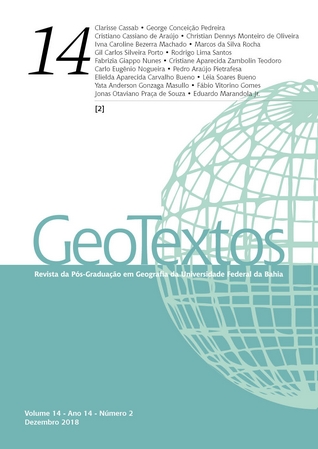GEOMORPHIC COMPATIBILITY AND IDENTIFICATION OF USE PATTERNS OF THE BASIN LAND COVER TIGER RILL
DOI:
https://doi.org/10.9771/geo.v14i2.28187Keywords:
Geomorphic compatibility, Lithological susceptibility, Geomorphic intensityAbstract
Many researches are developed in search of a closer follow-up of the problems detected in the semi-arid regions of northeastern Brazil. The monitoring of areas with agricultural potential, or any other type of production activity in these regions where they become more frequent since the regions need a monitoring and present this type of activity and also a better planning of the land management. Based on this, the environmental zoning becomes an important instrument for the classification of areas, where there are different procedures regarding the analysis of land use and coverage and geomorphic behaviors. In general, what refers to this aspect is a relationship between the use and relief of the tiger creek basin - PB, given as the relief comparisons that interact with the types of soil use and identify the levels of compatibility Geomorphic by means of the lithological predisposition interpolated with the topographic elements. The results showed an agricultural use area 80% compatible 18% moderately compatible and 2% incompatible according to the terrain found in the region.Downloads
Downloads
Published
How to Cite
Issue
Section
License
Autores que publicam nesta revista concordam com os seguintes termos:
Autores mantém os direitos autorais e concedem à revista o direito de primeira publicação, com o artigo simultaneamente licenciado sob a Licença Creative Commons Creative Commons CC BY que permite o compartilhamento do trabalho com reconhecimento da autoria e publicação inicial nesta revista. Esta licença permite que outros distribuam, remixem, adaptem e criem a partir do seu trabalho, mesmo para fins comerciais, desde que lhe atribuam o devido crédito pela criação original. É a licença mais flexível de todas as licenças disponíveis. É recomendada para maximizar a disseminação e uso dos materiais licenciados. Ver o resumo da licença em: https://creativecommons.org/licenses/by/4.0/ Ver o texto legal da licença em: https://creativecommons.org/licenses/by/4.0/ Consulte o site do Creative Commons: https://creativecommons.org/licenses/?lang=pt
Autores têm autorização para assumir contratos adicionais separadamente, para distribuição não-exclusiva da versão do trabalho publicada nesta revista (ex.: publicar em repositório institucional ou como capítulo de livro), com reconhecimento de autoria e publicação inicial nesta revista.
Autores têm permissão e são estimulados a publicar e distribuir seu trabalho online (ex.: em repositórios institucionais ou na sua página pessoal) a qualquer ponto antes ou durante o processo editorial, já que isso pode gerar alterações produtivas, bem como aumentar o impacto e a citação do trabalho publicado (Veja O Efeito do Acesso Livre).






